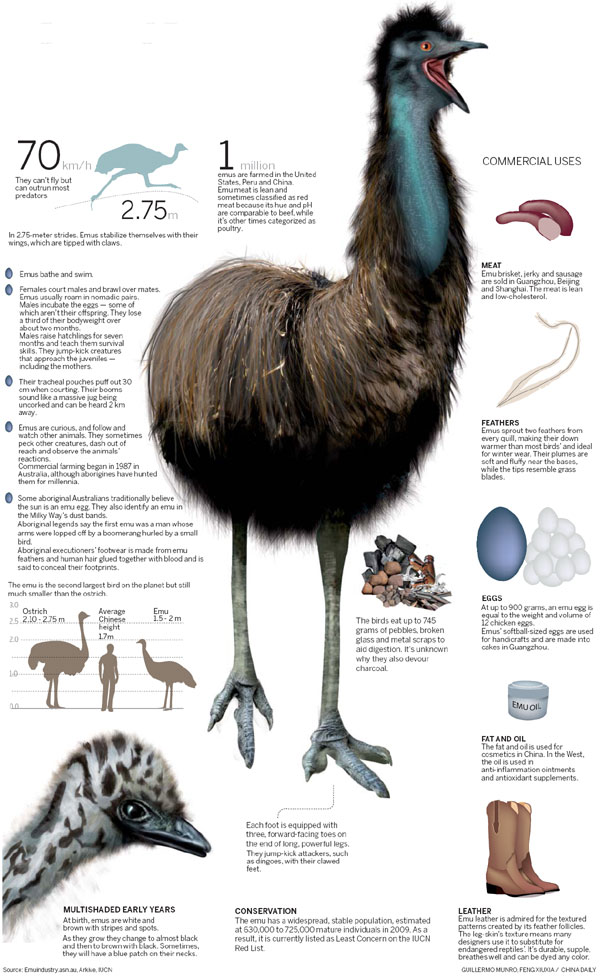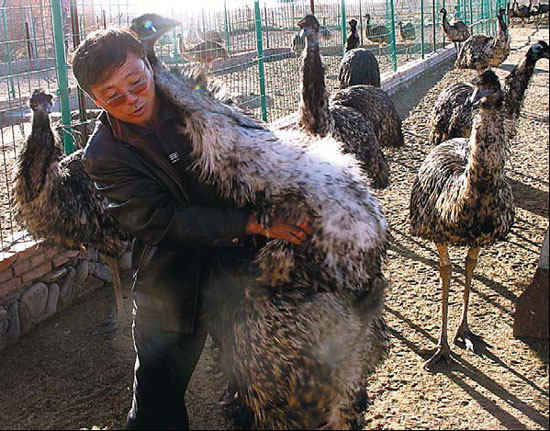Feasible fowl
Updated: 2012-12-05 07:52
By Erik Nilsson (China Daily)
|
|||||||||
|
OISCA project officer Wu Hasi checks an emu's health at the NGO's research institute in Alxa, Inner Mongolia autonomous region. Erik Nilsson / China Daily |
A Japanese NGO is piloting a project to replace sheep with emus in Inner Mongolia's grasslands. It could reduce overgrazing and enable ethnic Mongolian herders to earn more. Erik Nilsson finds out more.
When most people think of emus, they think of Australia's forests rather than Inner Mongolia's prairies - but that might soon change.
As China's government restricts sheep herding to alleviate the desertification of the Inner Mongolia autonomous region's Alxa grasslands, Japanese NGO the OISCA Institute for Alaxa Ecology is piloting a project to replace sheep with emus. This could reduce overgrazing and enable ethnic Mongolian herders to earn more.
These giant flightless birds can grow to 2 meters tall and weigh up to 35 kg. Local sheep are 20 to 30 kg - depending on their access to food, which has become scarcer as the Tengali, Badanjilin and Lanbuhe deserts devour Alxa's grasslands.
"The meat from an emu is a bit more than that from a sheep, but the environmental impact of its production is much less," explains OISCA project officer Wu Hasi.
Mutton sells locally for 50-60 yuan ($8-9.6) a kg, while emu meat can go for up to 100 yuan a kg.
There are 66 emus in Alxa, but the project needs 500 to slaughter sustainably.
Wu figures that will take about five years. The birds' numbers have doubled since they were purchased three years ago from Guangdong's provincial capital Guangzhou and Gansu province's capital Lanzhou.
But about 60 died because of inexpert care.
The NGO will give emu hatchlings - eggs incubate for about 55 days - to nomads and ranchers. It will buy them back after they've matured in 18 months.
"Our organization doesn't profit, but local people do," OISCA program officer Su Lide explains.
The NGO will then slaughter the emus and sell their meat for food, their oil and fat for cosmetics, their leather for luxury accessories and their feathers for clothing insulation. It's still studying pricing.
The most valuable emu meat products sold in Guangzhou, Beijing and Shanghai are brisket, jerky and sausage.
Emus sprout two feathers from each quill, making their down warmer than most birds'. These plumes also enable them to endure Alxa's -40 C winter winds despite having evolved in Australia's sweltering forests.
Emus' softball-sized eggs are used for handicrafts and made into cakes in Guangzhou.
"There isn't much emu meat in China's market," Wu says.
"People will buy it as a novelty."
But the giant flightless birds aren't only foreign to China's supermarkets - they're also alien to its ecology.
OISCA is concerned they might become feral or wild.
"That's our biggest fear," Wu says.
"They tend to return to their pens to eat grain, like chickens."
Several ran away in the first year, he says.
"Some we found," Wu says.
"Some we didn't. One turned up in a park years later."
However, because they don't over-consume and are disease resistant, it's unlikely wild emus would threaten Inner Mongolia's grasslands and deserts. The project site's flock prowls behind a high fence and an indoor area.
"Even if the emus escaped, they'd have little chance to increase in the wild in Alxa because they are small in number and people are quick to capture them," OISCA Japan International Cooperation Division's Counselor Fumio Kitsuki explains.
"Apparently, emus can't survive in the wild in Alxa. Actually, many of them that escaped were captured. The others returned to the breeder on their own.
"In the unlikely event of emus having increased by several thousand, it could be considered a festive event that the birds that became extinct hundreds of thousands of years ago have now returned to Eurasia."
Several extinct ratites (large flightless birds) roamed the area millions of years ago, including Struthio wimani, S. mengi, Zhongyuanus xichuanensis and Struthio linxiaensis. The Asian ostrich is believed to have died out just after the most recent ice age and arrival of humans in China, around 10,000 years ago.
Prehistoric Chinese pottery and rock carvings depict ostriches, which some suggest inspired the concept of the phoenix.
Today, Wu cares for Inner Mongolia's reintroduced ratites year-round at OISCA's research institute in Alxa - a lonely compound in the desert outside downtown.
"It's not a bad way to live," he says.
Wulanbatu'er is the only other local to raise emus so far.
The NGO selected the 55-year-old to bring up three of the birds to test the project's viability because he already raises about 600 chickens. These fowl bring in about 20,000 yuan a year for his family of seven.
"I had wondered if these animals are suitable to raise here," he says.
"They are. They're disease-resistant, which makes them better than chickens."
Wulanbatu'er lost about 130 chickens to illness this year.
He can sell his hens for about 40 yuan a kg - less than half the price emu meat fetches.
"I hope to raise more emus," he says. "It's a good deal."
Wulanbatu'er raised sheep until his prairie turned into desert about two decades ago.
"I don't have any grass to feed the sheep," he says.
"So, I turned to chickens. I can buy food for them. Raising poultry is much better, anyway. It's better for the environment. And I don't have to spend all day outside herding them in the freezing wind, especially in winter."
Wulanbatu'er says his family used to grow fruits. It's hard to imagine today that his mash of sand dunes was once lush. He says he lives in a different place than he grew up but never moved out of his house - an earthen dwelling without plumbing, powered by a solar panel.
Alxa's average per-capita income is about 3,000 yuan a year but is much lower among the 60,000 yurt-dwelling Mongolian nomads, who rove throughout the grasslands and deserts. Their earnings have been evaporating, too, as desertification broils the terrain's flora.
Wulanbatu'er believes there are many reasons the Tengali has swallowed his land.
"It's not just overgrazing," he says.
"It's industrialization, pollution and climate change - and probably other causes I don't even know."
But he has hope for the future, he says.
"Raising emus could turn this desert back into the grassland it was most of my life," Wulanbatu'er says.
"Herding sheep is more profitable than raising chickens. But chickens are better for the environment. Emus offer both advantages. They can help us rejuvenate the grasslands and make us more prosperous than ever."
Contact the writer at erik_nilsson@chinadaily.com.cn.

(China Daily 12/05/2012 page18)

 Relief reaches isolated village
Relief reaches isolated village
 Rainfall poses new threats to quake-hit region
Rainfall poses new threats to quake-hit region
 Funerals begin for Boston bombing victims
Funerals begin for Boston bombing victims
 Quake takeaway from China's Air Force
Quake takeaway from China's Air Force
 Obama celebrates young inventors at science fair
Obama celebrates young inventors at science fair
 Earth Day marked around the world
Earth Day marked around the world
 Volunteer team helping students find sense of normalcy
Volunteer team helping students find sense of normalcy
 Ethnic groups quick to join rescue efforts
Ethnic groups quick to join rescue efforts
Most Viewed
Editor's Picks

|

|

|

|

|

|
Today's Top News
Health new priority for quake zone
Xi meets US top military officer
Japan's boats driven out of Diaoyu
China mulls online shopping legislation
Bird flu death toll rises to 22
Putin appoints new ambassador to China
Japanese ships blocked from Diaoyu Islands
Inspired by Guan, more Chinese pick up golf
US Weekly

|

|








